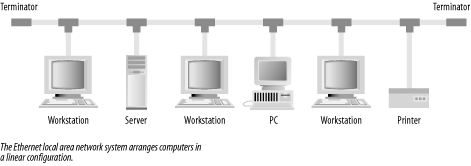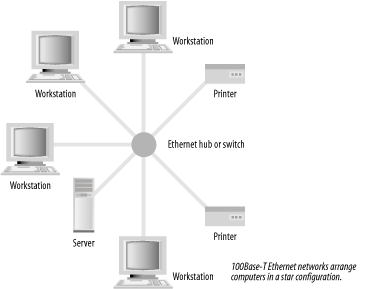|
|
11.1 NetworkingFrom a practical viewpoint, computer users today usually divide the world of networking into two halves:[1]
Figure 11-1. Ethernet local area network Figure 11-2. 100Base-T local area network Some authors also use the terms enterprise networks and metropolitan area networks (MANs). In general, these are simply combinations of LANs and WANs that serve a logically related group of systems. Many businesses started using LANs in the late 1980s and expanded into the world of WANs in the early 1990s. Nevertheless, the technology to network computers was actually developed in the reverse order: WANs were first developed in the early 1970s to network together timesharing computers that were used by many people at the same time. Later, in the early 1980s, LANs were developed after computers became less expensive and single-user computers became a financial reality. 11.1.1 The InternetOne of the first computer networks was the ARPANET, developed in the early 1970s by universities and corporations working under contract to the Department of Defense's Advanced Research Projects Agency (ARPA, sometimes known over the years as DARPA, depending on whether it was politically appropriate to emphasize the word "Defense"). The ARPANET linked computers around the world and served as a backbone for many other regional and campus-wide networks that sprang up in the 1980s. In the late 1980s, the ARPANET was superseded by the NSFNET, funded in part by the National Science Foundation. Funding for the NSFNET was cut in the early 1990s as commercial networks grew in number and scope. 11.1.1.1 Today's InternetToday, the descendant of the ARPANET is known as the Internet. The Internet is an IP-based[3] network that encompasses hundreds of millions of computers and more than a billion users throughout the world. Some of these computer systems are constantly connected, while others are connected only intermittently. Any one of those users can try to send you electronic mail, exchange files with your FTP file server, or break into your system—if your system is configured to allow them the access necessary to do so.
11.1.1.2 Who's on the Internet?In the early days of the ARPANET, the network was primarily used by a small group of research scientists, students, and administrative personnel. Security problems were rare: if somebody on the network was disruptive, tracking her down and having her disciplined was a simple matter. In extreme cases, people could lose their network privileges, or even their jobs (which usually produced the same result). In many ways, the Internet was a large, private club. These days the Internet is not so exclusive. The Internet has grown so large that you can almost never determine the identity of somebody who is trying to break into your system. Attackers may appear to be coming from a university in upstate New York, but the real story could be quite different. Attackers based in the Netherlands could have broken into a system in Australia, connected through that Australian computer to a system in South Africa, and finally connected through the South African system to a New York university. The attackers could then use the New York university as a base of operations to launch attacks against other sites, with little chance of being traced back home. This kind of site hopping is a common practice, sometimes called network weaving or connection laundering. Even if you are persistent and discover the true identity of your attacker, you may have no course of action: the attacks may be coming from a country that does not recognize breaking into computers as a crime. Or, the attacks may be coming from an agent of a foreign government, as part of a plan to develop so-called "information warfare" capabilities.[4] There is also activity by organized crime and by some attacks by agents of multinational corporations. In each of these cases, there may be considerable resources arrayed against any attempt to identify and prosecute the perpetrators. Finally, the attacker could be a minor or a person of relatively little means, eliminating any possibility of financial compensation—even if you achieve a conviction.
11.1.2 Networking and UnixUnix has both benefited from and contributed to the popularity of networking. Berkeley's 4.2 release in 1983 provided a straightforward and reasonably reliable implementation of the Internet Protocol (IP), the data communications standard that the Internet uses. That code has since been significantly improved and adopted by the majority of Unix vendors, as well as by vendors of many non-Unix systems. Today, Unix has many network services, including:
|
|
|